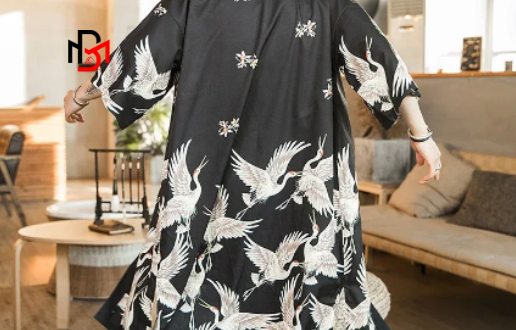Introduction
The haori is a traditional Japanese garment that has withstood the test of time, maintaining its cultural significance while evolving into a modern fashion staple. Originally worn by samurai, the haori has transcended its historical roots to become a versatile piece of clothing appreciated worldwide. This article delves into the rich history, cultural impact, and contemporary relevance of the haoris, exploring various styles such as the haori jacket, haori kimono, and adaptations inspired by popular media like anime and video games. Join us on a journey through the elegance and versatility of the haoris, and discover how this iconic garment can enhance your wardrobe.
A Brief History of the Haori: From Samurai Armor to Fashion Statement
Origins in Samurai Culture
The haori’s journey began in the Sengoku period (1467-1615), a time of great turmoil and conflict in Japan. Samurai warriors wore the haori over their armor to keep warm and shield themselves from the elements. These early haoris were practical garments, often plain and functional.
Transition to Merchant Class
During the Edo period (1603-1868), Japan experienced a prolonged era of peace, and the haori’s role evolved. The merchant class adopted the haori, transforming it into a symbol of status and fashion. These haoris were made from luxurious fabrics like silk and adorned with intricate patterns and designs, reflecting the wearer’s wealth and social standing.
Modern Adaptations
In contemporary times, the haori has undergone further transformation, blending traditional elements with modern fashion trends. Designers have experimented with materials, patterns, and cuts, making the haoris a versatile garment suitable for various occasions. From traditional ceremonies to casual streetwear, the haori continues to be a beloved piece of clothing that bridges the gap between the past and present.

Popular Culture and the Haori: Anime Influence
Gojo Haori: The Sleek Modern Look
The Gojo haori, inspired by the character Satoru Gojo from the anime Jujutsu Kaisen, represents a sleek and modern take on the traditional haoris. Gojo’s haoris is typically monochromatic, often in shades of white or black, reflecting his mysterious and powerful character. This minimalist design has become popular among fans of the series and those seeking a contemporary look with a touch of traditional flair.
Demon Slayer Haori: Iconic Anime Fashion
The anime series Demon Slayer has brought the haoris into the spotlight, with characters wearing distinctive haoris that symbolize their personalities and backgrounds. For instance, Tanjiro Kamado’s Demon Slayer haori features a green and black checkered pattern, symbolizing his connection to nature and his fighting spirit. The Shinobu haoris, adorned with butterfly motifs, reflects Shinobu Kocho’s grace and elegance, while the Rengoku haoris, with its flame pattern, embodies Kyojuro Rengoku’s fiery determination and strength.
Haoris in Gaming: Rengoku Haoris in Project Slayers
The haori’s influence extends beyond anime into the world of gaming. In the popular game Project Slayers, the Rengoku haoris is a coveted item, allowing players to channel the fiery spirit of Kyojuro Rengoku. This digital representation highlights the haori’s cultural impact and its integration into various entertainment mediums, showcasing its versatility and enduring appeal.
The Art of Haori: Patterns and Designs
Traditional Haori Patterns
Traditional haori patterns are steeped in symbolism and cultural significance. Common motifs include cherry blossoms, representing the fleeting beauty of life; cranes, symbolizing longevity and good fortune; and waves, signifying resilience and strength. These patterns are not only visually stunning but also carry deep meanings that reflect Japan’s rich cultural heritage.
Modern Haori Patterns
Modern haori patterns often blend traditional elements with contemporary designs. Geometric shapes, abstract art, and even references to popular culture can be found on modern haoris. This fusion of old and new creates a unique fashion statement that resonates with a global audience. Whether you prefer the classic elegance of traditional patterns or the bold creativity of modern designs, there is a haoris pattern to suit every taste.
How to Style a Haori: Tips and Tricks
Casual Chic
For a casual look, pair your haoris with jeans and a simple t-shirt. The haori adds a touch of elegance and uniqueness to an everyday outfit, making it perfect for casual outings or weekend get-togethers. Choose a haori with a subtle pattern or solid color for a relaxed yet stylish appearance.
Formal Elegance
For more formal occasions, layer your haori over a dress or tailored pants. Opt for haoris made from luxurious fabrics like silk or brocade to elevate your outfit. Accessorize with an obi belt or traditional Japanese jewelry to enhance the look and add a touch of sophistication. This style is ideal for events such as weddings, formal dinners, or cultural celebrations.
Cosplay and Themed Outfits
Anime and gaming fans often use haoris for cosplay, bringing their favorite characters to life. Whether you’re dressing up as a character from Demon Slayer or Jujutsu Kaisen, a well-chosen haoi can add authenticity to your costume. Look for specific designs like the Tanjiro haori or Rengoku haori to complete your look and impress fellow fans at conventions or themed parties.
Conclusion
The haori is more than just a garment; it is a symbol of Japan’s rich cultural heritage and its ability to adapt to modern fashion trends. Whether you are drawn to the traditional haoris kimono or the contemporary Gojo haori, this versatile jacket offers a unique blend of history and style. By incorporating a haoris into your wardrobe, you can embrace a piece of timeless elegance and make a fashion statement that transcends cultural boundaries. Celebrate the beauty and versatility of the haoris, and let it add a touch of sophistication and charm to your everyday attire.


